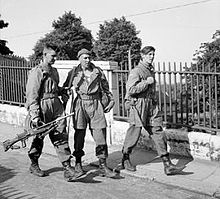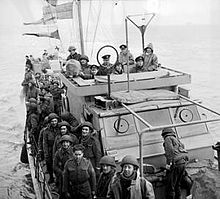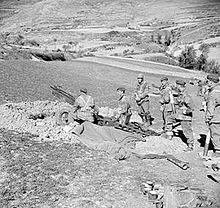- 1st Airborne Division (United Kingdom)
-
1st Airborne Division 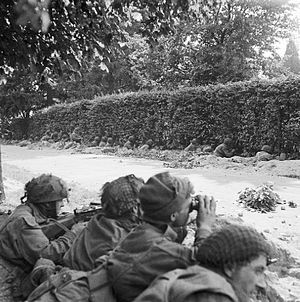
Men from the division during the battle of ArnhemActive 1941–1945 Country  United Kingdom
United KingdomBranch British Army Type Infantry Role Airborne forces Size Division, 12,148 men [1] Part of I Airborne Corps Nickname Red Devils [nb 1] Engagements Operation Biting
Operation Freshman
Operation Turkey Buzzard
Operation Ladbroke
Operation Fustian
Operation Slapstick
Battle of Arnhem
Operation DoomsdayCommanders Notable
commandersMajor-General Frederick Browning
Major General Roy UrquhartInsignia Identification
symbol
The 1st Airborne Division was a division of the British airborne forces during the Second World War. The division was formed in 1941, after British Prime Minister Winston Churchill demanded an airborne force. Its first two missions were raids; Operation Biting, a parachute landing in France, and Operation Freshman, a glider mission in Norway.
The division was sent to North Africa at the end of 1942, and during the Allied invasion of Sicily undertook two brigade sized landings. The first, Operation Ladbroke, carried out by a glider brigade, and the second, Operation Fustian, by a parachute brigade, were far from successful. The division then took part in a mostly diversionary amphibious landing, Operation Slapstick, part of the Allied invasion of Italy.
In December 1943, the division returned to England, and prepared for the invasion of North-West Europe. It was not involved in the Normandy landings, being held in reserve. In September 1944 it took part in Operation Market Garden. The division landed 60 miles (97 km) behind German lines, to capture crossings on the River Rhine, and fought in the Battle of Arnhem. After failing to achieve its objectives, the division was surrounded, but held out for nine days before the survivors were evacuated.
The 1st Airborne Division never fully recovered from their losses at Arnhem. Just after the end of the war, the depleted formation took part in Operation Doomsday in Norway. They were tasked with the disarmament and repatriation of the German occupation army. The division then returned to England and was disbanded in November 1945.
Contents
Background
Impressed by the success of German airborne operations during the Battle of France, the British Prime Minister, Winston Churchill, directed the War Office to investigate the possibility of creating a force of 5,000 parachute troops.[3] As a result, on 22 June 1940, No. 2 Commando assumed parachute duties, and on 21 November was re-designated the 11th Special Air Service Battalion, with a parachute and glider wing.[4][5]
On 21 June 1940 the Central Landing Establishment was formed at Ringway airfield near Manchester. Although tasked primarily with training parachute troops, it was also directed to investigate the use of gliders to transport troops into battle.[6][7] At the same time, the Ministry of Aircraft Production contracted General Aircraft Ltd to design and produce a glider for this purpose.[8] The result was the General Aircraft Hotspur, an aircraft capable of transporting eight soldiers, that was used for both assault and training purposes.[9]
The success of the first British airborne raid, Operation Colossus, prompted the War Office to expand the airborne force through the creation of the Parachute Regiment, and to develop plans to convert several infantry battalions into parachute and glider battalions.[10] On 31 May 1941, a joint army and air force memorandum was approved by the Chiefs-of-Staff and Winston Churchill; it recommended that the British airborne forces should consist of two parachute brigades, one based in England and the other in the Middle East, and that a glider force of 10,000 men should be created.[11]
Formation history
The existing 11th Special Air Service Battalion was renamed the 1st Parachute Battalion and, together with the newly raised 2nd and 3rd Parachute Battalions, formed the first of the new airborne formations, 1st Parachute Brigade,[12][13][nb 2] commanded by Brigadier Richard Nelson Gale.[14]
In October 1941, Frederick Browning was promoted to major-general, named the Commander Parachute and Airborne Troops, and ordered to form a headquarters to develop and train airborne forces.[13] The next unit formed was the 1st Airlanding Brigade on 10 October 1941, by the conversion of the mountain warfare trained 31st Independent Brigade Group, commanded by Brigadier George F. Hopkinson.[13][15] The brigade comprised four battalions: the 1st Border Regiment, 2nd South Staffordshire Regiment, 2nd Oxfordshire and Buckinghamshire Light Infantry, and the 1st Royal Ulster Rifles.[16] The men who were unsuitable for airborne forces were replaced by volunteers.[17] By the end of the year Browning's command had become the headquarters of 1st Airborne Division.[18]
1942–1943
Browning expressed his opinion that the force must not be sacrificed in "penny packets", and urged the formation of a third brigade.[19] Permission was finally granted in July 1942, and the 2nd Parachute Brigade, commanded by Brigadier Ernest Down, was formed. The Brigade was assigned the existing 4th Parachute Battalion,[19] and two new battalions converted from line infantry units, the 5th (Scottish) Parachute Battalion and the 6th (Royal Welch) Parachute Battalion.[20] The 3rd Parachute Brigade, comprising the 7th, 8th and the 9th Parachute Battalions, was formed in November 1943, and also assigned to the division.[20][21] Soon afterwards, the 1st Parachute Brigade left the division, to take part in the Operation Torch landings in North Africa.[22]
In April 1943, the commander of the 1st Airlanding Brigade, Hopkinson, was promoted to major-general and given command of the division.[23] Later that year, the division was deployed to Tunisia, for operations in the Mediterranean theatre of war.[nb 3] On arrival, it was reinforced by the 1st and 4th Parachute Brigades. The 4th Parachute Brigade had been formed in the Middle East during 1942. In addition to the 156th Parachute Battalion, which had been raised from British troops stationed in India,[24] it comprised the 10th and 11th Parachute Battalions, which had been raised from troops based in Egypt and Palestine.[25]
The division took part in two brigade sized operations in Sicily, and an amphibious assault at Taranto in Italy. During the fighting in Italy, Major-General Ernest Down became the divisional commander, after his predecessor died of wounds received in the fighting.[26] After service in the Mediterranean, the division returned to England in December 1943, leaving the 2nd Parachute Brigade behind as an independent formation.[26]
1944–1945
After the division arrived in England, Down was posted to India to oversee the formation of the 44th Indian Airborne Division, and was replaced by Major-General Roy Urquhart.[27] In September 1944, for Operation Market Garden in the Netherlands, the 1st Polish Parachute Brigade was attached to the division.[28] Following Market Garden, fewer than 2,200 men from the 10,000 that were sent to the Netherlands returned to Allied lines.[29] Having suffered such severe casualties, the 4th Parachute Brigade was disbanded, with its surviving men posted to the 1st Parachute Brigade.[30] The division then went through a period of reorganisation, but had still not fully recovered by the end of the war. Still under strength in May 1945, it was sent to Norway to disarm the German army of occupation; in November 1945 it returned to England and was disbanded.[31]
Operational history
France
Further information: Operation BitingOperation Biting, also known as the Bruneval Raid, was the codename for a raid by Combined Operations in 1942.[15] Their objective was a German Würzburg radar installation at Bruneval in France. Due to the extensive coastal defences erected by the Germans to protect the installation, it was thought a commando raid from the sea would incur heavy losses, and give sufficient time for the garrison at the installation to destroy the radar set. It was therefore decided that an airborne assault followed by sea-borne evacuation would be the ideal way to surprise the garrison of the installation and seize the technology intact.[18]
On the night of 27 February, 'C' Company, 2nd Parachute Battalion, under the command of Major John Frost, parachuted into France a few miles from the installation.[18] The force then proceeded to assault the villa in which the radar equipment was kept, killing several members of the German garrison and capturing the installation after a brief fire-fight.[32] A technician that had come with the force dismantled the Würzburg radar array and removed several key pieces to take back to Britain, and the raiding force then retreated to the evacuation beach. The detachment assigned to clear the beach had failed to do so, however, and another brief fire-fight was required to eliminate the Germans guarding the beach. The raiding force was then picked up by a small number of landing craft and transferred to several Motor Gun Boats which took them back to Britain. The raid was entirely successful. The airborne troops suffered only a few casualties, and the pieces of the radar they brought back, along with a German radar technician, allowed British scientists to understand German advances in radar and to create counter-measures to neutralise those advances.[33]
Norway
Further information: Operation FreshmanOperation Freshman was the first British airborne operation conducted using gliders, and its target was the Vemork Norsk Hydro chemical plant in Norway, which produced heavy water for Nazi Germany.[22] By 1942 the German atomic weapons programme had come close to being able to develop a nuclear reactor, but in order for the reactor to function it would require a great deal of heavy water. The source of the heavy water was the Norsk Hydro plant, which had been occupied in 1940; when the British government learned of the German nuclear developments, it was decided that a raid would be launched to destroy the plant and deny the Germans the heavy water required to develop a nuclear weapon.[34] Several tactics were discussed and discarded as impractical, and it was finally decided that a small force from the 1st Airborne Division, comprising 30 sappers from the Royal Engineers, would land by glider a short distance from the plant, and demolish it with explosives.[22]
Two aircraft, each towing one glider, left Scotland on the night of 19 November 1942. All managed to reach the Norwegian coast, but none were able to reach their objective. The first pair suffered from navigational difficulties and severe weather, which resulted in the tow rope snapping and the first glider crash-landing, with its towing aircraft returning to base; eight airborne troops were killed outright, four were severely injured and five unhurt, with the survivors captured shortly after the crash.[35] The second pair fared even worse, with both aircraft and glider crashing into a mountain for unknown reasons; the aircrew and several men were killed outright, and those who survived were taken prisoner.[36] None of the prisoners survived for very long, being either poisoned or executed as a result of Adolf Hitler's Commando Order, which stated all British Commandos personnel were to be killed immediately when captured.[22]
Sicily
Operation Turkey Buzzard, also known as Operation Beggar, was a supply mission to North Africa that took place between March and August 1943.[37] The mission was undertaken by the division's glider pilots and No. 295 Squadron Royal Air Force, as part of the preparations for the Allied invasion of Sicily.[38]
The mission involved Halifax bombers towing Horsa gliders 3,200 miles (5,100 km) from England to Tunisia.[39] The Horsas were needed to complement the smaller American Waco gliders, which did not have the capacity required for the planned operations.[38] During the mission two German Condor patrol aircraft located and shot down a Halifax-and-Horsa combination.[40] Altogether five Horsas and three Halifaxes were lost, but 27 Horsas arrived in Tunisia in time to participate in the invasion of Sicily.[41]
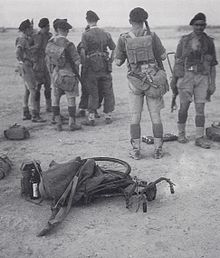 Men from the Border Regiment preparing to take off on Operation Ladbroke, with a folding airborne bicycle in the foreground
Men from the Border Regiment preparing to take off on Operation Ladbroke, with a folding airborne bicycle in the foreground
Operation Ladbroke was a glider assault by the 1st Airlanding Brigade near Syracuse, that began on 9 July 1943 as part of the invasion of Sicily. The brigade were equipped with 144 Waco gliders and six Horsa gliders. Their objective was land near the town of Syracuse, secure the Ponte Grande Bridge, and ultimately take control of the city itself with its strategically vital docks.[42]
On the way to Sicily, 65 gliders were released early by the towing aircraft and crashed into the sea, drowning around 252 men.[43] Of the remainder, only 87 men arrived at the Pont Grande Bridge, though they successfully captured the bridge and held it beyond the time they were to be relieved.[44] Finally, with their ammunition expended and only 15 soldiers remaining unwounded, they surrendered to the Italian forces. The Italians sought to demolish the bridge after regaining control of it, but were unable to do so because the airborne forces had removed the explosive charges.[44] Other troops from the airlanding brigade, who had landed elsewhere in Sicily, destroyed communications links and captured artillery batteries.[45]
Operation Fustian, the division's second mission in Sicily, was carried out by the 1st Parachute Brigade. Their objective was the Primosole Bridge across the Simeto River.[46] The intention was for the parachute brigade, with glider-borne forces in support, to land on both sides of the river.[47] While one battalion seized the bridge, the other two battalions would establish defensive positions to the north and south.[48] They would then hold the bridge until relieved by the advance of XIII Corps, part of the Eighth Army which had landed on the south eastern coast three days previously.[49]
The start of the operation was a disaster. Many of the aircraft carrying the paratroopers from North Africa were shot down, or were damaged and turned back, due to both friendly fire and enemy action.[50] The evasive action taken by the pilots scattered the brigade over a large area, and only the equivalent of two companies of troops were landed in the correct locations.[48][51] Despite this and the defence by German and Italian forces, the British paratroops captured the bridge. Resisting attacks from the north and south, they held out against increasing odds until nightfall.[51]
The relieving force led by the 50th (Northumbrian) Infantry Division, which was short of transport, found it hard going to reach the parachute brigade and were still 1 mile (1.6 km) away when they halted for the night.[52] By this time, with casualties mounting and supplies running short, the brigade commander, Brigadier Gerald Lathbury, had relinquished control of the bridge to the Germans.[53] The following day the British units joined forces, and the 9th Battalion, Durham Light Infantry with armour support attempted to recapture the bridge. The bridge was not finally secured until three days after the start of the operation, when another battalion of the Durham Light Infantry, led by the paratroopers, established a bridgehead on the northern bank of the river.[53]
Italy
Further information: Operation SlapstickOperation Slapstick was an amphibious landing at the Italian port of Taranto, part of the Allied invasion of Italy in September 1943.[54] The mission had been planned at short notice, following an offer by the Italian government to open the ports of Taranto and Brindisi on the heel of Italy to the Allies.[55] The 1st Airborne Division was selected to undertake the mission, but at the time they were located in North Africa.[54] A shortage of transport aircraft meant the division could not land by parachute and glider, and all the landing craft in the area were already allocated to the other landings: Operation Avalanche at Salerno on the western coast, and Operation Baytown at Calabria.[56][57] Instead, the division had to be transported across the Mediterranean by ships of the Royal Navy.[58] The landing was unopposed, and the airborne division successfully captured the ports of Taranto, and later Brindisi on the Adriatic coast, in working order.[59]
The only German forces in the area were elements of the 1st Parachute Division,[60] which engaged the advancing British in ambushes and at roadblocks during a fighting withdrawal north. By the end of September, the 1st Airborne Division advanced 125 miles (201 km) to Foggia. Reinforcements from two infantry divisions had by then been landed behind them, which allowed the airborne troops to be withdrawn back to Taranto.[61][62]
England
By December 1943 the division had returned to England and begun training for operations in North-West Europe under the supervision of I Airborne Corps. Although the 1st Airborne Division was not scheduled to take part in the Normandy landings, a contingency plan, Operation Wastage, was drawn up whereby the division would be parachuted in to support any of the five invasion beaches if serious delays were experienced. This turned out not to be required.[63]
While the 6th Airborne Division were still fighting in Normandy, numerous plans to parachute the 1st Airborne Division into France were formulated, all to no avail. In June and July 1944, the plans included Operation Reinforcement, which was a landing to the west of St Sauveur-le-Vicomte to support the American 82nd Airborne Division, and Operation Wild Oats to seize Carpiquet airfield in support of the 1st Canadian Army. There was also Operation Beneficiary, intended to support the American XX Corps in capturing St Malo, and Operation Lucky Strike which had the objective of seizing bridges across the River Seine at Rouen. In Operation Sword Hilt, the division was to isolate the port of Brest and destroy the Morlaix viaduct. Operation Hands Up was intended to support the American Third Army by seizing the Vannes airfield.[64]
By August the division was still waiting to be deployed, but now plans envisioned using them as part of a larger force. Operation Transfigure involved the division, the 52nd (Lowland) Infantry Division, the American 101st Airborne Division, and the 1st Polish Parachute Brigade landing at Rambouillet St Arnoult, to close the gap between Orleans and Paris. Operation Axehead, using the same force, was to seize the bridges over the River Seine in support of 21st Army Group. Operation Boxer, again with the same force, was to seize Boulogne and assault V1 flying bomb sites.[65] Near the end of the month, Operation Linnet, with the same units as before, was formulated to seize crossings over the Escaut. Operation Infatuate, drawn up in early September, involved the entire I Airborne Corps landing in Belgium to trap the retreating German armies in the Scheldt estuary, as well as aiming to threaten Antwerp.[66]
Finally, in September, there was Operation Comet, in which the division's three brigades were to land in the Netherlands and each capture a river crossing. The first of these was the bridge over the River Waal at Nijmegen, the second the bridge over the River Maas at Grave, and the last was the bridge over the River Rhine at Arnhem.[67] Planning for Comet was well advanced when on 10 September the mission was cancelled. Instead, a new operation was proposed with the same objectives as Comet but to be carried out by three divisions of the 1st Allied Airborne Army.[68]
 Men of 156th Parachute Battalion in Oosterbeek, where the majority of 1st Airborne Division became trapped
Men of 156th Parachute Battalion in Oosterbeek, where the majority of 1st Airborne Division became trapped
Arnhem
Further information: Battle of Arnhem and Operation Market GardenOperation Market Garden in September 1944, was an airborne assault by three divisions in the Netherlands, to secure key bridges and towns along the expected Allied axis of advance. Farthest north, the 1st Airborne Division, supported by the Polish 1st Independent Parachute Brigade, landed at Arnhem to secure bridges across the Nederrijn. Initially expecting a walkover, British XXX Corps planned to reach the British airborne forces within two to three days.[28]
The 1st Airborne Division landed some distance from their objectives and were quickly hampered by unexpected resistance – especially from elements of the 9th SS and 10th SS Panzer Divisions.[69] Only a small force was able to reach the Arnhem road bridge while the main body of the division was halted on the outskirts of the city.[69] Meanwhile, XXX Corps was unable to advance north as quickly as anticipated and failed to relieve the airborne troops on schedule.[70] After four days, the small British force at the bridge was overwhelmed and the rest of the division became trapped in a pocket north of the river – where they could not be sufficiently reinforced by the Poles or XXX Corps when they arrived on the southern bank.[70] After nine days of fighting, the shattered remains of the airborne forces were eventually withdrawn south of the Rhine. The 1st Airborne Division had lost 8,000 men during the battle and never saw combat again.[29]
Norway post war
Further information: Operation DoomsdayIn May 1945, immediately after the Allied victory in Europe, the 1st Airborne Division was sent to disarm and repatriate the 350,000 strong German occupation army in Norway.[71] The division maintained law and order until the arrival of the remainder of Force 134, the occupation force. During its time in Norway, the division was tasked with supervising the surrender of the German forces in Norway, as well as preventing the sabotage of vital military and civilian facilities.[30]
The German Instrument of Surrender was delivered on 8 May to General Franz Böhme, the commander of all German forces stationed in Norway, and the 1st Airborne Division landed near Oslo and Stavanger between 9 May and 11 May.[72][73] Most of the transport aircraft carrying the division landed safely, but one crash caused several fatalities.[74] The division encountered little of the expected German resistance.[75] Operational duties included welcoming back King Haakon VII of Norway, looking after Allied ex-prisoners of war, arresting war criminals and supervising the clearing of minefields.[75] While in Norway, the division was also able to investigate what happened to the airborne troops that had taken part in Operation Freshman.[30] The division returned to Britain, and was disbanded on 26 August 1945.[71]
Order of battle
Commanders
- Major-General Frederick Browning
- Major-General George F. Hopkinson
- Major-General Ernest Down
- Major-General Roy Urquhart
Units
- 1st Parachute Brigade
- 1st Airlanding Brigade
- 2nd Parachute Brigade
- 3rd Parachute Brigade
- 4th Parachute Brigade
- Divisional troops
- Divisional headquarters and signal squadron
- 1st Airlanding Light Regiment, Royal Artillery
- 1st Forward (Airborne) Observation Unit, Royal Artillery
- 21st Independent Parachute Company Army Air Corps
- 1st Airborne Reconnaissance Squadron
- 9th (Airborne) Field Company, Royal Engineers
- 261st (Airborne) Field Park Company, Royal Engineers
- 250th (Airborne) Light Company, Royal Army Service Corps
- 93rd Company, Royal Army Service Corps
- Detachment Ordnance Field Park
- Detachment, Royal Electrical and Mechanical Engineers Workshop
- 89th Field Security Section, Intelligence Corps
- 1st Airborne Division, Provost Company, Royal Military Police[16][76]
Notes
- Footnotes
- ^ The 1st Parachute Brigade had been called the "Rote Teufel" or "Red Devils" by the German troops they had fought in North Africa. The title was officially confirmed by General Harold Alexander and henceforth applied to all British airborne troops.[2]
- ^ The 2nd and 3rd Battalions were formed from volunteers, between the ages of twenty-two and thirty-two, who were already serving in infantry units. Only ten men from any one unit were allowed to volunteer.[13]
- ^ The 3rd Parachute Brigade and two battalions from the airlanding brigade—the 2nd Oxfordshire and Buckinghamshire Light Infantry and 1st Royal Ulster Rifles—remained behind in England, forming the nucleus of the 6th Airborne Division.[16]
- Citations
- ^ Gregory, p.50
- ^ Otway, p.88
- ^ Otway, p.21
- ^ Shortt and McBride, p.4
- ^ Moreman, p.91
- ^ Otway 1990, pp. 28–29
- ^ Smith, p.7
- ^ Flint, p.73
- ^ Lynch, p.31
- ^ Harclerode, p. 218
- ^ Tugwell p.123
- ^ Ferguson, p.6
- ^ a b c d Tugwell, p.125
- ^ Tugwell, p.124
- ^ a b Ferguson, p.7
- ^ a b c Ferguson, p.15
- ^ Blockwell and Clifton, p.63
- ^ a b c Tugwell, p.126
- ^ a b Ferguson, p.8
- ^ a b Horn, p.270
- ^ Gregory, p.53
- ^ a b c d Ferguson, p.9
- ^ Ferguson, p.11
- ^ Ferguson, p.10
- ^ Ferguson, pp.10–11
- ^ a b Ferguson, p.13
- ^ Ferguson, p.16
- ^ a b Ferguson, p.21
- ^ a b Ferguson, p.26
- ^ a b c Ferguson, p.30
- ^ Ferguson. p.46
- ^ Tugwell, pp.126–127
- ^ Tugwell, p.127
- ^ Tugwell, p.139
- ^ Tugwell, pp.139–140
- ^ Tugwell, p.140
- ^ Smith, p.153
- ^ a b Peters and Buist, p.12
- ^ Seth, p.77
- ^ "Obituary Tommy Grant". Daily Telegraph. http://www.telegraph.co.uk/news/obituaries/1354357/His-Honour-D-A-Tommy-Grant.html. Retrieved 21 June 2011.
- ^ Lloyd, pp.43–44
- ^ Harclerode, p.256
- ^ Mitcham, pp.73–74
- ^ a b Mitcham, p.75
- ^ Mrazek, p.79
- ^ Tugwell, p.159
- ^ Mrazek, p.83
- ^ a b Reynolds, p.37
- ^ Mitcham, p.335
- ^ Mrazek, p.84
- ^ a b Mitcham, p.152
- ^ Tugwell, p.165
- ^ a b Quarrie, p.77
- ^ a b Cole, p.51
- ^ Blumenson, p.60
- ^ Tugwell, p.168
- ^ Blumenson, p.26
- ^ Cole, p.52
- ^ Blumenson, p.114
- ^ Molony, p.243
- ^ Cavendish, p.17
- ^ Prasad, p.368
- ^ Peters and Buist, p.10
- ^ Peters and Buist, p.19
- ^ Peters and Buist, p.21
- ^ Peters and Buist, p.26
- ^ Peters and Buist, p.28
- ^ Peters and Buist, pp.40–41
- ^ a b Ferguson, p.22
- ^ a b Ferguson, p.25
- ^ a b "Operation Varsity". Ministry of Defence (United Kingdom). 26 March 2004. http://tna.europarchive.org/20061101003926/http://www.army.mod.uk/para/history/rhine.htm. Retrieved 12 August 2011.
- ^ Hart, p.228
- ^ Otway, p.327
- ^ Otway, p.326
- ^ a b Otway, p.328
- ^ Urquhart, p.225
References
- Blockwell, Albert; Clifton, Maggie (2005). Diary of a Red Devil: By Glider to Arnhem with the 7th King's Own Scottish Borderers. Solihill, United Kingdom: Helion & Company Limited. ISBN 1874622132.
- Blumenson, Martin (1969). United States Army in World War 2, Mediterranean Theater of Operations, Salerno to Cassino. Washington DC: Defense Department Army, Government Printing Office. OCLC 631290895.
- Cavendish, Marshall (2010). Global Chaos World War II. World War II. New York: Marshall Cavendish Benchmark. ISBN 0761449485.
- Cole, Howard N (1963). On wings of healing: the story of the Airborne Medical Services 1940–1960. Edinburgh: William Blackwood. OCLC 29847628.
- Ferguson, Gregor (1984). The Paras 1940–84. Volume 1 of Elite series. Oxford, UK: Osprey Publishing. ISBN 0850455731.
- Flint, Keith (2006). Airborne Armour: Tetrarch, Locust, Hamilcar and the 6th Airborne Armoured Reconnaissance Regiment 1938–1950. Solihull, UK: Helion & Company Ltd. ISBN 187462237X.
- Guard, Julie (2007). Airborne: World War II Paratroopers in Combat. Oxford, UK: Osprey Publishing. ISBN 1846031966.
- Gregory, Barry; Batchelor, John (1979). Airborne warfare, 1918–1945. Exeter, Devon: Exeter Books. ISBN 978-0896730250.
- Harclerode, Peter (2005). Wings Of War – Airborne Warfare 1918–1945. London: Weidenfeld & Nicolson. ISBN 0304367303.
- Horn, Bernd; Wyczynski, Michael (2003). Paras versus the Reich Canada's paratroopers at war, 1942–45. Toronto, Canada: Dundurn Press Ltd. ISBN 9781550024708.
- Lynch, Tim (2008). Silent Skies: Gliders At War 1939-1945. Barnsley, UK: Pen & Sword Military. ISBN 0750306335.
- Lloyd, Alan (1982). The Gliders: The story of Britain's fighting gliders and the men who flew them. Ealing, United Kingdom: Corgi. ISBN 0552121673.
- Mitcham, Samuel W; Von Stauffenberg, Friedrich (2007). The Battle of Sicily: How the Allies Lost Their Chance for Total Victory. Stackpole Military History Series. Mechanicsburg, Pennsylvania: Stackpole Books. ISBN 081173403X.
- Molony, Brigadier C.J.C.; with Flynn, Captain F.C. (R.N.); Davies, Major-General H.L. & Gleave, Group Captain T.P. (2004) [1st. pub. HMSO:1973]. Butler, Sir James. ed. The Mediterranean and Middle East, Volume V: The Campaign in Sicily 1943 and The Campaign in Italy 3rd September 1943 to 31st March 1944. History of the Second World War, United Kingdom Military Series. Uckfield, UK: Naval & Military Press. ISBN 1845740696.
- Moreman, Timothy Robert (2006). British Commandos 1940–46. Oxford, UK: Osprey Publishing. ISBN 184176986X.
- Mrazek, James (2011). Airborne Combat: Axis and Allied Glider Operations in World War II. Military History Series. Mechanicsburg, Pennsylvania: Stackpole Books. ISBN 081170808X.
- Otway, Lieutenant-Colonel T.B.H (1990). Army – Airborne Forces in the Second World War. London: Imperial War Museum. ISBN 0901627577.
- Peters, Mike; Luuk, Buist (2009). Glider Pilots at Arnhem. Barnsley, UK: Pen & Sword Books. ISBN 1844157636.
- Prasad, Bisheshwar (1956). The Campaigns in the Western Theatre Official History of the Indian Armed Forces in the Second World War, 1939–1945. Calcutta: Combined Inter-Services Historical Section. OCLC 164872723.
- Quarrie, Bruce (2005). German Airborne Divisions: Mediterranean Theatre 1942–45. Volume 15 of Battle Orders. Oxford, UK: Osprey Publishing. ISBN 1841768286.
- Reynolds, David (1998). Paras: An Illustrated History of Britain's Airborne Forces. Stroud, UK: Sutton Publishing. ISBN 0750920599.
- Saunders, Hilary Aidan St. George (1950). The Red Beret: the Story of the Parachute Regiment at War, 1940–1945 (4 ed.). Torrington, UK: Michael Joseph. OCLC 2927434.
- Seth, Ronald (1955). Lion with blue wings: the story of the Glider Pilot Regiment, 1942–1945. London: Gollancz. OCLC 7997514.
- Shortt, James; McBride, Angus (1981). The Special Air Service. Oxford, UK: Osprey Publishing. ISBN 0850453968.
- Smith, Claude (1992). History of the Glider Pilot Regiment. London: Pen & Sword Aviation. ISBN 1844156265.
- Thompson, Major-General Julian (1990). Ready for Anything: The Parachute Regiment at War. Fontana, California: Fontana Press. ISBN 0006375057.
- Tugwell, Maurice (1971). Airborne to Battle: A History of Airborne Warfare, 1918–1971. London: Kimber. ISBN 0718302621.
- Urquhart, Robert (2007). Arnhem. Barnsley, UK: Pen and Sword Books Ltd. ISBN 9781844155378.
- Wilson, R. D (2008). Cordon and Search: with 6th Airborne Division in Palestine. Barnsley, UK: Pen & Sword Military. ISBN 1844157717.
 British airborne units of the Second World War
British airborne units of the Second World WarParachute battalions: 1st Parachute Battalion · 2nd Parachute Battalion · 3rd Parachute Battalion · 4th Parachute Battalion · 5th (Scottish) Parachute Battalion · 6th (Royal Welch) Parachute Battalion · 7th (Light Infantry) Parachute Battalion · 8th (Midlands) Parachute Battalion · 9th (Eastern and Home Counties) Parachute Battalion · 10th Parachute Battalion · 11th Parachute Battalion · 11th Special Air Service Battalion · 12th (Yorkshire) Parachute Battalion · 13th (Lancashire) Parachute Battalion · 15th (King's) Parachute Battalion · 16th (Staffords) Parachute Battalion · 17th Parachute Battalion · 151st Parachute Battalion · 156th Parachute BattalionAirlanding battalions: Artillery: 1st Airlanding Light Regiment · 53rd (Worcester Yeomanry) Airlanding Light RegimentReconnaissance: 6th Airborne Armoured Reconnaissance RegimentField ambulances: 16th (Parachute) Field Ambulance · 127th (Parachute) Field Ambulance · 133rd (Parachute) Field Ambulance · 181st (Airlanding) Field Ambulance · 195th (Airlanding) Field Ambulance · 224th (Parachute) Field Ambulance · 225th (Parachute) Field AmbulanceGlider Pilots: Brigades: Divisions: 1st Airborne Division · 6th Airborne Division
Corps: 1st Airborne Corps
Categories:- Parachute Regiment (United Kingdom)
- Military units and formations established in 1941
- Military units and formations disestablished in 1945
- Airborne divisions of the United Kingdom
Wikimedia Foundation. 2010.

